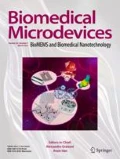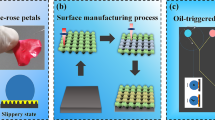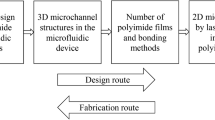Abstract
Fluidic patterning is a convenient and versatile tool for the patterning of materials, cells and microstructures on surface and in microchannels. However, its performance is usually limited by transverse diffusion between fluid streams. It would blur the boundary and deteriorate the precision of patterns. In this paper, we adopted geometric confinement to generate biphasic parallel flow that is constituted of oil and water. Since there is minimum transverse diffusion in biphasic parallel flow, the performance of fluid patterning is expected to be improved. The results show that the metal (Silver and Chromium) patterns have distinct boundary and well-controlled geometry in comparison with that by conventional laminar flow patterning. Furthermore, the high biocompatibility of oil phase (perfluorodecalin, PFD) enables the precise patterning of viable bacteria inside microchannels. Our work demonstrated a new route of using biphasic parallel flow to patterning, which would serve wide applications in prototyping and research settings.







Similar content being viewed by others
References
E. Berthier, J. Warrick, B. Casavant, D.J. Beebe, Pipette-friendly laminar flow patterning for cell-based assays. Lab Chip 11, 2060–2065 (2011)
A. Bransky, N. Korin, S. Levenberg, Experimental and theoretical study of selective protein deposition using focused micro laminar flows. Biomed. Microdevices 10, 421–428 (2008)
H.J. Busscher, H.C. van der Mei, How do bacteria know they are on a surface and regulate their response to an adhering state? PLoS Pathog. 8, e1002440 (2012)
L. Chen, G. Yang, S.T. Wang, Air-grid surface patterning provided by superhydrophobic surfaces. Small 8, 962–965 (2012)
S. Cho, S.J. Park, S.Y. Ko, J.O. Park, S. Park, Development of bacteria-based microrobot using biocompatible poly(ethylene glycol). Biomed. Microdevices 14, 1019–1025 (2012)
J. Clausell-Tormos, D. Lieber, J.C. Baret, A. El-Harrak, O.J. Miller, L. Frenz, J. Blouwolff, K.J. Humphry, S. Koster, H. Duan, C. Holtze, D.A. Weitz, A.D. Griffiths, C.A. Merten, Droplet-based microfluidic platforms for the encapsulation and screening of mammalian cells and multicellular organisms. Chem. Biol. 15, 427–437 (2008)
R. Dreyfus, P. Tabeling, H. Willaime, Ordered and disordered patterns in two-phase flows in microchannels. Phys. Rev. Lett. 90, 144505 (2003)
J.P. Frampton, D. Lai, H. Sriram, S. Takayama, Precisely targeted delivery of cells and biomolecules within microchannels using aqueous two-phase systems. Biomed. Microdevices 13, 1043–1051 (2011)
Y.X. Gao, L.W. Chen, Versatile control of multiphase laminar flow for in-channel microfabrication. Lab Chip 8, 1695–1699 (2008)
P. Garstecki, M.J. Fuerstman, H.A. Stone, G.M. Whitesides, Formation of droplets and bubbles in a microfluidic T-junction - scaling and mechanism of break-up. Lab Chip 6, 437–446 (2006)
M. Geissler, Y.N. Xia, Patterning: principles and some new developments. Adv. Mater. 16, 1249–1269 (2004)
Z.Y. Han, W.T. Li, Y.Y. Huang, B. Zheng, Measuring rapid enzymatic kinetics by electrochemical method in droplet-based microfluidic devices with pneumatic valves. Anal. Chem. 81, 5840–5845 (2009)
P.Y. He, D. Barthes-Biesel, E. Leclerc, Flow of two immiscible liquids with low viscosity in Y shaped microfluidic systems: effect of geometry. Microfluid. Nanofluid. 9, 293–301 (2010)
I.T. Horváth, Fluorous biphase chemistry. Acc. Chem. Res. 31, 641–650 (1998)
P.B. Howell, J.P. Golden, L.R. Hilliard, J.S. Erickson, D.R. Mott, F.S. Ligler, Two simple and rugged designs for creating microfluidic sheath flow. Lab Chip 8, 1097–1103 (2008)
C.H. Hsieh, C.J.C. Huang, Y.Y. Huang, Patterned pdms based cell array system: a novel method for fast cell array fabrication. Biomed. Microdevices 12, 897–905 (2010)
X.W. Huang, L. Li, Q. Tu, J.C. Wang, W.M. Liu, X.Q. Wang, L. Ren, J.Y. Wang, On-chip cell migration assay for quantifying the effect of ethanol on Mcf-7 human breast cancer cells. Microfluid. Nanofluid. 10, 1333–1341 (2011)
K.J. Humphry, A. Ajdari, A. Fernandez-Nieves, H.A. Stone, D.A. Weitz, Suppression of instabilities in multiphase flow by geometric confinement. Phys. Rev. E 79, 056310 (2009)
R.F. Ismagilov, A.D. Stroock, P.J.A. Kenis, G. Whitesides, H.A. Stone, Experimental and theoretical scaling laws for transverse diffusive broadening in two-phase laminar flows in microchannels. Appl. Phys. Lett. 76, 2376–2378 (2000)
X.Y. Jiang, D.A. Bruzewicz, A.P. Wong, M. Piel, G.M. Whitesides, Directing cell migration with asymmetric micropatterns. Proc. Natl. Acad. Sci. U. S. A. 102, 975–978 (2005)
G. Jing, S.F. Perry, S. Tatic-Lucic, Precise cell patterning using cytophobic self-assembled monolayer deposited on top of semi-transparent gold. Biomed. Microdevices 12, 935–948 (2010)
A.S. Kabalnov, K.N. Makarov, O.V. Shcherbakova, A.N. Nesmeyanov, Solubility of fluorocarbons in water as a key parameter determining fluorocarbon emulsion stability. J. Fluor. Chem. 50, 271–284 (1990)
P.J.A. Kenis, R.F. Ismagilov, G.M. Whitesides, Microfabrication inside capillaries using multiphase laminar flow patterning. Science 285, 83–85 (1999)
P.J.A. Kenis, R.F. Ismagilov, S. Takayama, G.M. Whitesides, S.L. Li, H.S. White, Fabrication inside microchannels using fluid flow. Acc. Chem. Res. 33, 841–847 (2000)
T. Kong, J. Wu, M. To, K. Wai Kwok Yeung, H. Cheung Shum, L. Wang, Droplet based microfluidic fabrication of designer microparticles for encapsulation applications. Biomicrofluidics 6, 034104 (2012)
J.N. Lee, C. Park, G.M. Whitesides, Solvent compatibility of poly(dimethylsiloxane)-based microfluidic devices. Anal. Chem. 75, 6544–6554 (2003)
L. Li, Y. Nie, X.T. Shi, H.K. Wu, D.T. Ye, H.D. Chen, Partial transfection of cells using laminar flows in microchannels. Biomicrofluidics 5, 036503 (2011)
D.R. Lide, Crc handbook of chemistry and physics, 86th Edn, 2005–2006 (CRC Press, Boca Raton, 2005), pp. 41–45. Section 16
H.B. Mao, P.S. Cremer, M.D. Manson, A sensitive, versatile microfluidic assay for bacterial chemotaxis. Proc. Natl. Acad. Sci. U. S. A. 100, 5449–5454 (2003)
L.F. Mottram, S. Forbes, B.D. Ackley, B.R. Peterson, Hydrophobic analogues of rhodamine B and rhodamine 101: potent fluorescent probes of mitochondria in living C. elegans. Beilstein J. Org. Chem. 8, 2156–2165 (2012)
X. Mu, Q.L. Liang, P. Hu, K.N. Ren, Y.M. Wang, G.A. Luo, Laminar flow used as “liquid etch mask” in wet chemical etching to generate glass microstructures with an improved aspect ratio. Lab Chip 9, 1994–1996 (2009)
X. Mu, W. Zheng, J. Sun, W. Zhang, X. Jiang, Microfluidics for manipulating cells. Small 9, 9–21 (2013)
Z.H. Nie, E. Kumacheva, Patterning surfaces with functional polymers. Nat. Mater. 7, 277–290 (2008)
L. Peng, M. Yang, S.S. Guo, W. Liu, X.Z. Zhao, The effect of interfacial tension on droplet formation in flow-focusing microfluidic device. Biomed. Microdevices 13, 559–564 (2011)
T.T. Perkins, D.E. Smith, S. Chu, Single polymer dynamics in an elongational flow. Science 276, 2016–2021 (1997)
B. Regenberg, U. Kruhne, M. Beyer, L.H. Pedersen, M. Simon, O.R.T. Thomas, J. Nielsen, T. Ahl, Use of laminar flow patterning for miniaturised biochemical assays. Lab Chip 4, 654–657 (2004)
K.N. Ren, Q.L. Liang, X. Mu, G.A. Luo, Y.M. Wang, Miniaturized high throughput detection system for capillary array electrophoresis on chip with integrated light emitting diode array as addressed ring-shaped light source. Lab Chip 9, 733–736 (2009)
K. Ren, Y. Chen, H. Wu, New materials for microfluidics in biology. Curr. Opin. Biotechnol. 25, 78–85 (2014)
A. Sauret, H.C. Shum, Forced generation of simple and double emulsions in all-aqueous systems. Appl. Phys. Lett. 100, 154106 (2012)
H.C. Shum, Y.J. Zhao, S.H. Kim, D.A. Weitz, Multicompartment polymersomes from double emulsions. Angew. Chem. Int. Edit. 50, 1648–1651 (2011)
H.C. Shum, J. Varnell, D.A. Weitz, Microfluidic fabrication of water-in-water (W/W) jets and emulsions. Biomicrofluidics 6, 012808 (2012)
J.R. SooHoo, G.M. Walker, Microfluidic aqueous two phase system for leukocyte concentration from whole blood. Biomed. Microdevices 11, 323–329 (2009)
J.E. Squires, Artificial blood. Science 295, 1002–1005 (2002)
T.M. Squires, S.R. Quake, Microfluidics: fluid physics at the nanoliter scale. Rev. Mod. Phys. 77, 977–1026 (2005)
K. Sun, L.S. Song, Y.Y. Xie, D.B. Liu, D. Wang, Z. Wang, W.S. Ma, J.S. Zhu, X.Y. Jiang, Using self-polymerized dopamine to modify the antifouling property of oligo(ethylene glycol) self-assembled monolayers and its application in cell patterning. Langmuir 27, 5709–5712 (2011)
K. Sun, Y.Y. Xie, D.K. Ye, Y.Y. Zhao, Y. Cui, F. Long, W. Zhang, X.Y. Jiang, Mussel-inspired anchoring for patterning cells using polydopamine. Langmuir 28, 2131–2136 (2012)
S. Takayama, J.C. McDonald, E. Ostuni, M.N. Liang, P.J.A. Kenis, R.F. Ismagilov, G.M. Whitesides, Patterning cells and their environments using multiple laminar fluid flows in capillary networks. Proc. Natl. Acad. Sci. U. S. A. 96, 5545–5548 (1999)
M.W. Toepke, S.H. Brewer, D.M. Vu, K.D. Rector, J.E. Morgan, R.B. Gennis, P.J.A. Kenis, R.B. Dyer, Microfluidic flow-flash: method for investigating protein dynamics. Anal. Chem. 79, 122–128 (2007)
J. Wang, W.H. Pei, B. Yuan, K. Guo, K. Sun, H.B. Sun, H.D. Chen, An integrated device for patterning cells and selectively detaching. Biomed. Microdevices 14, 471–481 (2012)
B. Yao, G.A. Luo, X. Feng, W. Wang, L.X. Chen, Y.M. Wang, A microfluidic device based on gravity and electric force driving for flow cytometry and fluorescence activated cell sorting. Lab Chip 4, 603–607 (2004)
X. Zhou, L. Lau, W.W.L. Lam, S.W.N. Au, B. Zheng, Nanoliter dispensing method by degassed poly(dimethylsiloxane) microchannels and its application in protein crystallization. Anal. Chem. 79, 4924–4930 (2007)
W.A. Zisman, Influence of constitution on adhesion. Ind. Eng. Chem. 55, 18–38 (1963)
Acknowledgments
This work was supported by National Science and Technology Major Project of China (2013ZX09507005), National Natural Science Foundation of China (21305162, 21235004 and 21175080), the Importation and Development of High-Caliber Talents Project of Beijing Municipal Institutions (to Q. L.). The authors thank Prof. Xingyu Jiang in National Center of Nanoscience and Technology for providing fluorescence microscope, and Prof. Bo Zheng at Chinese University of HongKong, Prof. Bo Yao at Zhejiang University and Prof. Ho Cheung Shum at The University of HongKong for fruitful discussions.
Author information
Authors and Affiliations
Corresponding authors
Electronic supplementary material
Rights and permissions
About this article
Cite this article
Mu, X., Liang, Q., Zhou, J. et al. Oil–water biphasic parallel flow for the precise patterning of metals and cells. Biomed Microdevices 16, 245–253 (2014). https://doi.org/10.1007/s10544-013-9828-y
Published:
Issue Date:
DOI: https://doi.org/10.1007/s10544-013-9828-y




